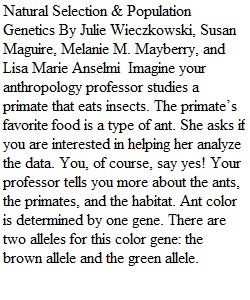


Q Goal To model the impact of a selective agent, an insectivorous primate, on a population of ants. You will calculate changes in allele frequencies within a population and document how selective pressures can change allele frequencies and cause evolution to occur in the ant population. Additionally, you will write and test a hypothesis. Content Citation: Wieczkowski, Julie, Maguire, Susan, Mayberry, Melanie M. and Andelmi, LIsa Marie. 2021. Natural Selection Links to an external site.. Explorations Lab and Activities Manual. Prompt Imagine your anthropology professor studies a primate that eats insects. The primate’s favorite food is a type of ant. She asks if you are interested in helping her analyze the data. You, of course, say yes! Your professor tells you more about the ants, the primates, and the habitat. Ant color is determined by one gene. There are two alleles for this color gene: the brown allele and the green allele. The primates eat the ants year-round, but your professor knows that the way they eat the ants differs between the rainy season and the dry season. During the rainy season, when there are green leaves on the trees, the primates eat the ants off the green leaves. During the dry season, when the trees lose their leaves, the primates eat the ants off the brown tree branches. Your professor has collected data to investigate if the primate acts as a selective pressure on the ant population, possibly changing the allele frequencies over time. Instructions Please open the Week 5 - Natural Selection and Population Genetics Handout Download Week 5 - Natural Selection and Population Genetics Handoutto follow the steps and record your observations and results. Type your answers in the word document below the numbered questions and in the tables where there are empty cells. Save the document to your computer, adding your initials to the file name, and submit the finished version to this assignment. Please use only .docs or .pdf file types. You will need a calculator to complete some of the steps in this activity. Grading Learning and growth take practice and reflection and I am here to support your efforts. All assignments will receive an initial grade based on the provided rubric. If you aren't happy with the points you receive or need to improve your submission, everyone will have the option to review my feedback, revise your work, and resubmit your assignment by the "available until" date 1 week after the original due date. If you have questions about how to improve a submission or about my feedback, please ask me. My goal is to provide feedback within 72 hours, at the latest, of the due date for the assignment. Technical Help How do I submit an online assignment?Links to an external site. How do I upload a file as an assignment submission in Canvas?Links to an external site. How do I submit assignments in the Canvas Student App on my smartphone?Links to an external site. How do I enter a URL as an assignment submission?Links to an external site. How do I view the rubric for my assignment?Links to an external site. How do I know when my assignment has been submitted?Links to an external site. How do I know when my instructor has graded my assignment?Links to an external site. How do I view assignment comments from my instructor?Links to an external site. PreviousNext
View Related Questions